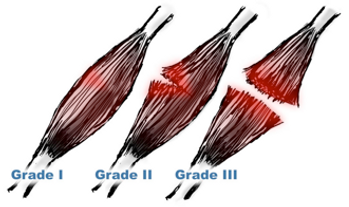Classification of a Ligament Sprain
Sprains are classified into three grades of severity, ranging from over-stretching to complete tearing of the ligament. In a severe sprain, the ligament may pull off a piece of the bone, resulting in an avulsion fracture.
-
Grade I (mild) – Slight stretching of the ligament with some damage to fibers; Minimal swelling and tenderness; Minimal to no functional loss; No ligament laxity (joint is stable); Typical healing is 2-10 days.
-
Grade II (moderate) – Partial tear of ligament; Moderate swelling, pain, or tenderness; Mild to moderate ligament laxity (joint may be unstable); Typical healing time is 10-30 days.
-
Grade III (severe) – Complete tear of ligament; Significant swelling, bruising, and tenderness; Positive for ligament laxity (joint instability); Recommendation is to consult with a physician to rule out a fracture. May take 30-90 days to recover.

References
How to Manage Acute Inflammation:
You have heard of RICE for managing inflammation, but how about PRICEMEM? Protect, Rest, Ice, Compress, Elevate, Manual Therapy, Early Motion, Medication.
The basic concepts of RICE are still practiced, but we now encourage more comprehensive guidelines for a quicker recovery for athletes experiencing musculoskeletal injuries.
The goals in the initial stage of Acute Inflammation are to decrease swelling, improve circulation, and restore range of motion.
PROTECT: You must protect the injured tissue from overuse and reinjury during the healing process. For a weightbearing joint, it might require the use of crutches, a boot, or a brace. For a shoulder injury, it might require the use of a sling. Pain is often a good indicator that a tissue is being stressed and should be protected.
REST: Injured tissue needs time to progress through the healing stages and may require a period of rest in order for swelling and inflammation to subside. “Rest” is relative and does not necessarily mean to avoid all activity.
ICE: Ice reduces swelling of the affected area, minimizing secondary hypoxic injury to surrounding tissues. Ice for 15-20 minutes, 2-3 times per day in the acute phase of injury.
COMPRESS: Compression using a wrap will reduce excess swelling of the affected area.
ELEVATE: Elevating the area of injury above your heart can reduce accumulation of excess fluid.
MANUAL THERAPY: Manual therapy by a Physical Therapist can be helpful in reducing swelling and pain, while promoting circulation and mobility. A Physical Therapist can also help to restore muscle balance, decrease scar tissue development, and normalize biomechanics.
EARLY MOTION: Early motion will prevent stiffness, promote circulation, and improve pain-free mobility.
MEDICATION: Medication may be prescribed by a physician to control pain and swelling in the acute phase of injury.
